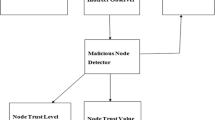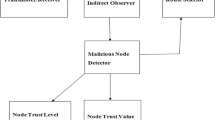Abstract
MANETs are wireless networks where nodes have very high mobility. Energy loss and dropping of packets are a common phenomenon in MANETs. Establishing a viable route between the source and the destination is the next big challenge in MANETs. We propose a new fuzzy dynamic cluster routing protocol (FDCRP) which incorporates a trusted waterfall framework that tries to address all of the prevalent issues concerning MANETs. Our proposed work will eliminate the need to find a new route from the source to the destination. Instead it would try to establish a route with the help of a peer group of clusters as the packet travels towards the target node. The loss of energy due to frequent clustering can be mitigated by circulating the node information to all the nodes within the communication range. This is done by using a dynamic broadcasting method to propagate the node information involving a natural technique called ant colony optimization involving fuzzy rules. This information sharing would help a MANET to form clusters dynamically even when the nodes move to a new region. The cluster head would be identified beforehand and will be nominated automatically when the new cluster is formed, thus reducing the time and energy involved in cluster oriented operations. We also incorporate a three tier filtering scheme to isolate the trusted nodes in forming a cluster, as there is a heavy possibility that the cluster nodes or even the cluster head turning malicious in the course of a transmission. The FDCRP protocol will help in improving the network performance when compared to the previous network scenario.












Similar content being viewed by others
References
Abbasi, A. A., & Younis, M. (2007). A survey on clustering algorithms for wireless sensor networks. Computer Commnication, 30(14/15), 2826–2841.
Tselikis, C., Mitropoulos, S., Komninos, N., & Douligeris, C. (2012). Degree-based clustering algorithms for wireless ad hoc networks under attack. IEEE Communications Letters, 16(5), 619–621.
Zeng, Y., Cao, J., Guo, S., Yang, K., & Xie, L. (2009) SWCA: A secure weighted clustering algorithm in wireless ad hoc networks. In IEEE wireless communications and networking conference WCNC.
Nishimura, I., Nagase, T., Takehana, Y., & Yoshioka, Y. (2011). Secure clustering for building certificate management nodes in ad-hoc network. In International conference on network-based information systems, (2011) (pp. 685–689).
Rifà-Pous, H., & Herrera-Joancomartí, J. (2011). A fair and secure cluster formation process for ad hoc networks. Journal Wireless Personal Communications: An International Journal Archive, 56(3), 625.
Sivaranjani, V., & Rajalakshmi, D. (2012). Secure cluster head election for intrusion detection in MANET. Journal of Computer Applications, 5(EICA2012-4), 10.
Bechler, M., Hof, H., Kraft, D., Pahlke, F., & Wolf, L. (2004). A cluster-based security architecture for Ad Hoc networks. In Proceedings of the 23rd annual joint conference of the IEEE computer and communications societies (INFOCOM’04) (vol. 4, pp. 2393–2403).
Adams, W. J., & Davis, N. J. (2005). Toward a decentralized trust based access control system for dynamic collaboration. In Proceedings of the 6th Annual IEEE System, Man and Cybernetics Information Assurance Workshop (SMC’05) (pp. 317–324).
Boukerche, A., & Ren, Y. (2008). A security management scheme using a novel computational reputation model for wireless and mobile Ad Hoc networks. In Proceedings of the 5th ACM international symposium on performance evaluation of wireless ad-hoc, sensor, and ubiquitous networks (PE-WASUN’08) (pp. 88–95).
Li, R., Li, J., Liu, P., & Chen, H. (2007). An objective trust management framework for mobile Ad Hoc networks. In Proceedings of the IEEE 65th vehicular technology conference (VTC’07) (pp. 56– 60).
Theodorakopoulos, G., & Baras, J. S. (2004). Trust evaluation in adhoc networks. In Proceedings of the ACM workshop on wireless security (WiSe’04) (pp. 1–10).
Jiang, T., & Baras, J. S. (2004). Ant-based adaptive trust evidence distribution in MANET. In Proceedings of the 24th international conference on distributed computing systems workshops (pp. 588–593).
Yan, Z., Zhang, P., & Virtan, T. (2003). Trust evaluation based security solution in Ad Hoc networks. In Proceedings of 7th Nordic workshop on secure IT systems.
Pirzada, A. A., & McDonald, C. (2004). Establishing trust in pure ad-hoc networks. In Proceedings of the 27th Australasian conference on computer science (ACSC’04) (vol. 26, pp. 47–54).
Ghosh, T., Pissinou, N., & Makki, K. (2004). Collaborative trust based secure routing in multihop Ad Hoc networks. In Proceedings of the 3rd international IFIP-TC6 networking conference on networking technologies, services, and protocols; performance of computer and communication networks; mobile and wireless communications of Lecture Notes in Computer Science, Athens, Greece, May 9–14, 2004 (vol. 3042, pp. 1446–1451).
Ghosh, T., Pissinou, N., & Makki, K. (2005). Towards designing a trusted routing solution in mobile Ad Hoc networks. Mobile Networks and Applications, 10(6), 985–995.
Milan, F., Jaramillo,J. J., & Srikant, R. (2006). Achieving cooperation in multihop wireless networks of selfish nodes. In Proceedings of the workshop on game theory for communications and networks (GameNets’06).
Safa, H., Artail, H., & Tabet, D. (2010). A cluster-based trust-aware routing protocol for mobile Ad Hoc networks. Wireless Networks, 16(4), 969–984.
Chatterjee, M., Das, S. K., & Turgut, D. (2002). WCA: A weighted clustering algorithm for mobile Ad Hoc networks. Journal of Cluster Computing, 5(2), 193–204.
Chatterjee, P., Sengupta, I., & Ghosh, S. K. (2012). STACRP: a secure trusted auction oriented clustering based routing protocol for MANET. Cluster Computing, 15, 303–320.
Sathiamoorthy, J., Ramakrishnan, B., & Usha. M. (2015). A reliable and secure data transmission in CEAACK MANETs using Distinct Dynamic Key with classified Digital Signature Cryptographic Algorithm. In IEEE international conference on computing and communications technologies (ICCCT).
Sathiamoorthy, J., & Ramakrishnan, B. (2016). CEAACK—a reduced acknowledgment for better data transmission for MANETs. International Journal of Computer Network and Information Security, 2, 64–71.
Sathiamoorthy, J., Ramakrishnan, B., & Usha, M. (2015). Design of a competent broadcast algorithm for reliable transmission in CEAACK MANETs. Journal of Network Communications and Emerging Technologies, 5(1), 144–151.
Sathiamoorthy, J., & Ramakrishnan, B. (2017). A competent three-tier fuzzy cluster algorithm for enhanced data transmission in cluster EAACK MANETs. Springer Soft Computing 11 July 2017 (Online) (pp. 1–21).
Sathiamoorthy, J., & Ramakrishnan, B. (2017). A reliable data transmission in EAACK MANETs using hybrid three-tier competent fuzzy cluster algorithm. Wireless Personal Communication, 94, 1–20.
Sathiamoorthy, J., & Ramakrishnan, B. (2016). Energy and delay efficient dynamic cluster formation using improved ant colony optimization algorithm in EAACK MANETs. Wireless Personal Communication, 95, 1–122.
Sathiamoorthy, J., & Ramakrishnan, B. (2015). Energy and delay efficient dynamic cluster formation using hybrid AGA with FACO in EAACK. Journal of Wireless Networks, 23, 1–15.
Ali, H., Shahzad, W., & Khan, F. A. (2012). Energy-efficient clustering in mobile ad-hoc networks using multi-objective particle swarm optimization. Applied Soft Computing, 12, 1913–1928.
Yadav, S., & Jain, R. (2012). Attacks in MANET. International Journal of Latest Trends in Engineering and Technology (IJLTET), 1(3), 273.
Lalar, S. (2014). Security in MANET: Vulnerabilities, attacks & solutions. International Journal of Multidisciplinary and Current Research, 2, 62.
Buchegger, S., & Boudec, J. (2002). Performance analysis of the confidant protocol cooperation of nodes fairness in dynamic ad-hoc networks. In Proceedings of international symposium on mobile ad hoc networking and computing mobihoc and 2002 (pp. 226–236).
Liu, J., & Issarny, V. (2004). Enhanced reputation mechanism for mobile ad hoc networks. In Proceedings of 2nd international conference on trust management.
Anderegg, L., & Eidenbenz, S. (2003). Ad hoc-VCG: A truthful and cost efficient routing protocol for mobile ad hoc networks with selfish agents. In Proceedings of mobile computing network, 2003 (pp. 245–259).
Author information
Authors and Affiliations
Corresponding author
Additional information
Publisher's Note
Springer Nature remains neutral with regard to jurisdictional claims in published maps and institutional affiliations.
Rights and permissions
About this article
Cite this article
Mohanakrishnan, U., Bhagavathiperumal, R. & Jayaraman, S. A Trusted Waterfall Framework Based Peer to Peer Protocol for Reliable and Energy Efficient Data Transmission in MANETs. Wireless Pers Commun 102, 95–124 (2018). https://doi.org/10.1007/s11277-018-5829-8
Published:
Issue Date:
DOI: https://doi.org/10.1007/s11277-018-5829-8




